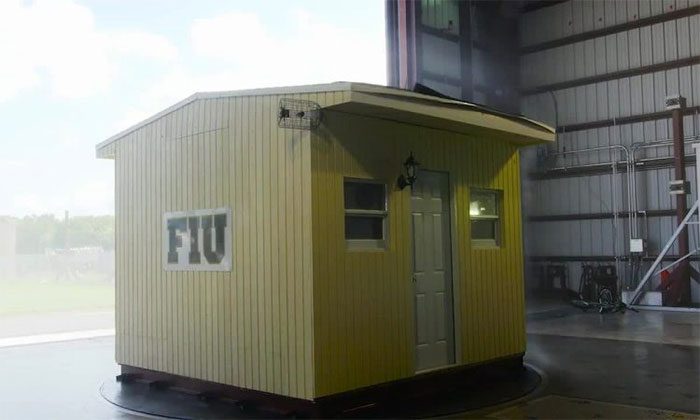“The Wall of Wind” at Florida International University is recreated to help engineers test the structural integrity of buildings against winds reaching up to 257 km/h.
In a hangar in Miami, engineers are recreating some of the strongest storms in the world that have made landfall. Category 5 winds can destroy a test house in the blink of an eye.
Testing the wind resistance of a house. (Video: Palm Beach Post)
When engineers built the Wall of Wind testing facility at Florida International University a decade ago, they were inspired by Hurricane Andrew, a “monster” storm that devastated southern Florida in 1992. This facility was designed to test the wind resistance of structures against winds of up to 257 km/h. However, today, stronger storms are becoming more frequent, such as Hurricane Dorian, which devastated residential areas in the Bahamas with winds of 296 km/h in 2019, and Hurricane Patricia, which had winds of 346 km/h, destroying coastal areas in Mexico in 2015.
Research shows that tropical storms are increasing in intensity due to climate change, as well as rising ocean and atmospheric temperatures. Designing homes and infrastructure to withstand future storms like Dorian requires many new wind simulation facilities. Currently, Florida International University is the only testing facility capable of generating category 5 hurricane winds, the strongest classification on the U.S. scale.
On one side of the facility is a curved wall equipped with 12 gigantic fans, each as tall as an adult. When combined, these fans can recreate winds of 257 km/h. Water jets simulate rain being blown sideways. The other side of the facility opens up to a large field where engineers can observe how structures collapse and how debris scatters. Simulating strong storms allows them to identify weaknesses in design and construction, monitor damage across buildings, and test advanced solutions under conditions close to real storms. Cameras and sensors record every millisecond as the house, roofing materials, and many other components either withstand or are shattered by the wind.
Ten years of research at this facility have helped builders and designers mitigate damage risks. In a destructive test, the team at Florida International University found that when wind sweeps over the weakest point, the structure often suffers damage in less than a second.

Roofs are vulnerable to uplift forces during a storm.
When Hurricane Dorian swept through the Bahamas, many poorly built homes turned into rubble, creating another problem. After one house collapsed, nearby homes built to withstand higher winds were also at risk from flying debris. The researchers’ experiments showed how debris from one house could strike a nearby house under sustained winds of 209 – 225 km/h.
Roofs are often the weakest part. Roofs are susceptible to uplift forces during a storm, so the wind hitting the surface of the house needs an escape route. When the wind sweeps over objects in its path, it can cause damage. New designs aim to improve the wind resistance of homes. For example, storms can create swirling winds that can lift materials and even the entire roof. One solution is to use turbines along the roof’s edge to disperse wind forces while generating energy. The shape of the house can also create weaknesses or contribute to redirecting the wind. Most modern skyscrapers avoid sharp angles. Test results show that trapezoidal or circular edges can help reduce wind pressure on buildings.
The experiments conducted by researchers at Florida International University demonstrate how auxiliary systems, such as metal components positioned too high or too low between walls and roofs, can cause a house to collapse under relatively low wind speeds, even if designed to withstand category 5 hurricanes.
As engineers gather data through testing, the nature of storms is also gradually changing due to a warming planet. Higher temperatures from increased greenhouse gas emissions from human activities result in air holding more moisture, and warmer oceans provide additional energy for storms. Research indicates that increasingly powerful storms carry more water and move slower, devastating the areas they pass through with wind, storm surge, flooding, and debris. This is why the research team at Florida International University is collaborating with eight other universities to design a new facility to test construction under wind conditions of 322 km/h, along with a water tank to assess the impact of 6-meter-high storm surges.
Computers can model outcomes, but models still need validation through real-world testing. By combining the effects of wind, storm surge, and flooding, the research team can observe how all components interact in a storm and impact residents and the built environment.





















































